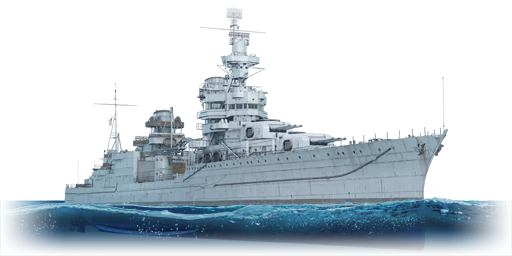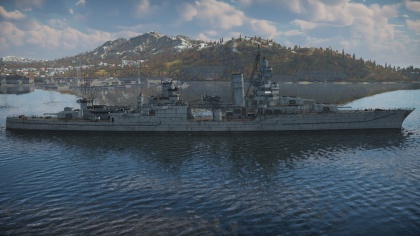USS Portland
Contents
Description
The Portland-class, USS Portland (CA-33), 1942 is a rank American heavy cruiser
with a battle rating of (AB), (RB), and (SB). It was introduced in Update 1.97 "Viking Fury".
General info
Survivability and armour
Talk about the vehicle's armour. Note the most well-defended and most vulnerable zones, e.g. the ammo magazine. Evaluate the composition of components and assemblies responsible for movement and manoeuvrability. Evaluate the survivability of the primary and secondary armaments separately. Don't forget to mention the size of the crew, which plays an important role in fleet mechanics. Save tips on preserving survivability for the "Usage in battles" section. If necessary, use a graphical template to show the most well-protected or most vulnerable points in the armour.
Mobility
Write about the ship's mobility. Evaluate its power and manoeuvrability, rudder rerouting speed, stopping speed at full tilt, with its maximum forward and reverse speed.
| Mobility Characteristics | |||
|---|---|---|---|
| Game Mode | Upgrade Status | Maximum Speed (km/h) | |
| Forward | Reverse | ||
| AB | |||
| Upgraded | |||
| RB/SB | |||
| Upgraded | |||
Armament
Primary armament
The Portland carries a main armament of nine 8’’/55 Mk.15 Guns in three triple turrets, two fore and one aft. These guns are the standard armament for American heavy cruisers, and pack an impressive punch. The guns have good ballistics, and can access four shell types: Mk.14 Common, Mk.19 APCBC, Mk.25 HC and Mk.17 SP Common. Of these shells, the Mk.17 Special Common shell is most effective against cruisers, as it has a great explosive mass and enough penetration for most cruiser main armour belts. The Mk.19 APCBC shell can be used against heavily-armoured targets, but has a relatively small explosive mass of 1.65 kg. Finally, the HC shell, with almost 10 kilograms of explosive filler, is highly effective against destroyers and unarmoured vessels.
However, the guns have two main drawbacks. Firstly, they have the slowest reload speed of any 8’’ gun, with a fire rate of just three rounds per minute (20-second gun reload). This means that they fire much slower than their contemporaries, which typically have a fire rate of five rounds per minute (12-second reload). As well, the guns have the slowest horizontal turret rotation speed of any heavy cruiser, at just 3.1 degrees/second (comparatively, the Admiral Hipper’s guns rotate at 6.8 degrees/second).
Secondary armament
The Portland carries a secondary armament of eight 5’’/25 Mk.13 anti-aircraft guns, mounted on single open-mounts. These cannons are very effective medium-to-long range anti-aircraft guns, but are not effective against any armoured targets. They have access to just two shell types - Mk.36 AAC (HE-TF) and Mk.28 AAC (HE-VT). The former is a time-fuse shell (meaning that the fuze is set before the weapon is fired), while the latter is a proximity fuze shell that explodes automatically upon reaching the target. Both shells are ineffective against armoured targets, having ~35mm of penetration. However, they are both capable of dealing with air and unarmoured targets quite effectively. The HE-VT shell is typically the better pick, as it offers greatly-improved efficiency against air vehicles.
The guns themselves are relatively good at short-range defence, being capable of firing at 20 rounds per minute (3-second reload). As well, they have very good vertical and horizontal firing angles. However, take note that the guns fire at a low muzzle velocity of 657 m/s which should be accounted for when manually aiming.
Anti-aircraft armament
Portland carries four quadruple 1.1 inch "Chicago Pianos". The 1.1 inch/75 Mk.1 Gun, otherwise known as the “Chicago Piano” (because it was the size of a baby grand-piano), was the standard anti-aircraft armament for most American ships prior to the introduction of the 40 mm Bofors cannon. These guns are mediocre at best; though they have a good fire rate (similar to the AN/M2 Browning), they aren’t too effective at dealing damage, and also jam rather quickly. As well, take note that the gun doesn’t have ammunition options.Portland also carries twelve single 20mm Oerlikon cannons. The 20mm Oerlikon Cannon was the standard light anti-aircraft gun for several nations, including the United States, and replaced the prior AN/M2 Browning machine gun. This weapon is an effective short-range AA gun, and has great firing angles. The gun lacks belt options, but the loaded ammunition is still quite effective against light targets. As well, the guns fire from a drum magazine that will need to be reloaded. Because of the magazine design, the gun will not jam with continuous fire.
Usage in battles
Describe the technique of using this ship, the characteristics of her use in a team and tips on strategy. Abstain from writing an entire guide – don't try to provide a single point of view, but give the reader food for thought. Talk about the most dangerous opponents for this vehicle and provide recommendations on fighting them. If necessary, note the specifics of playing with this vehicle in various modes (AB, RB, SB).
Modules
| Tier | Seakeeping | Unsinkability | Firepower | |||
|---|---|---|---|---|---|---|
| I | Dry-Docking | Tool Set | 8 inch Mk.19 APCBC | Anti-Air Armament Targeting | ||
| II | Rudder Replacement | Fire Protection System | Smokescreen | 8 inch Mk.25 HC | Auxiliary Armament Targeting | |
| III | Propeller Replacement | Shrapnel Protection | Ventilation | 5 inch Mk.28 AAC-VT | Primary Armament Targeting | Improved Rangefinder |
| IV | Engine Maintenance | New Pumps | Ammo Wetting | 8 inch Mk.17 SP Common | ||
Pros and cons
Pros:
- Improved armour protection from HE shrapnel compared to the Brooklyn
- Reasonably modern AA defences
- Thicker armour over main magazines than the Brooklyn
- Crew of 848 is above average
Cons:
- Long reload compared to most of its competition with minimum reload at 17.1 s
- Poor shell selection with primarily inter-war shells
- No torpedo armament
History
The Portland-class cruisers were the third heavy cruiser design that the Americans produced in the interwar years, following the Northampton class. There were only two ships in this class, the USS Portland (CA-33) and the USS Indianapolis (CA-35). Interestingly the Portland class was originally planned to be a light cruiser design, being re-designated as heavy cruisers only after the hulls had been laid down in 1931.
Ships of the class were propelled by 4 screws, powered at 107,000 horsepower. This gave the ship a fairly standard top speed of 32 knots and a cruising range of 10,000 nautical miles.
Firepower was provided from 3 triple 8" guns in Mk. 14 turrets. This design was carried over from the previous Northampton class. These 280 ton turrets allowed a maximum of 41 degrees of elevation and 5 degrees of depression. The turrets were used in conjunction with the Mk.34 fire director system by, at the latest, 1945.
Media
Excellent additions to the article would be video guides, screenshots from the game, and photos.
See also
Links to articles on the War Thunder Wiki that you think will be useful for the reader, for example:
- reference to the series of the ship;
- links to approximate analogues of other nations and research trees.
External links
Paste links to sources and external resources, such as:
- topic on the official game forum;
- encyclopedia page on the ship;
- other literature.
| Bethlehem Steel Corporation | |
|---|---|
| Gun Destroyers (DD) | |
| Porter-class | USS Phelps · USS Moffett |
| Fletcher-class | USS Cowell |
| Destroyer Leaders (DL) | |
| Mitscher-class | USS Wilkinson |
| Cruiser, Light (CL) | |
| Omaha-class | USS Raleigh · USS Detroit |
| Heavy Cruisers (CA) | |
| Northampton-class | USS Northampton |
| Portland-class | USS Portland |
| Baltimore-class | USS Baltimore · USS Pittsburgh |
| Des Moines-class | USS Des Moines |
| USA heavy cruisers | |
|---|---|
| Pensacola-class | USS Pensacola |
| Northampton-class | USS Northampton |
| Portland-class | USS Portland |
| New Orleans-class | USS New Orleans |
| Baltimore-class | USS Baltimore · USS Pittsburgh |
| Des Moines-class | USS Des Moines · USS Newport News |





